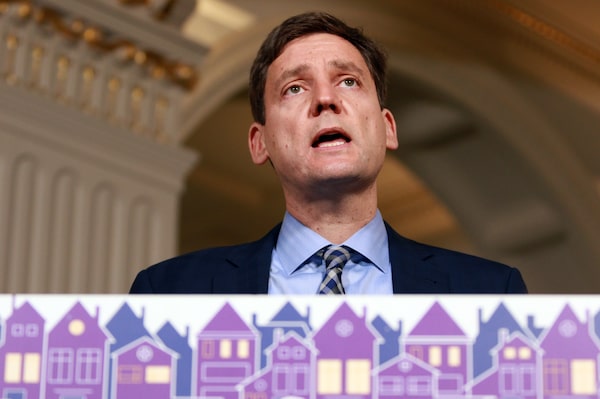After year of record-breaking imports, BC Hydro rolls out new ...
B.C. Premier David Eby says a planned 10-year, $36 billion expansion of the province's electrical system will open economic opportunities and ensure ample power to supply the province's growing population.CHAD HIPOLITO/The Canadian Press

BC Hydro has rewritten its 10-year capital plan to include what it says will be an unprecedented level of construction, as the Crown-owned utility struggles to meet its customers’ growing demand for electricity.
British Columbia Premier David Eby announced the new $36-billion capital plan, up from the previous $24-billion, on Tuesday evening during a resource forum in Prince George. In an interview Wednesday, he said the revised plan will help prevent future energy shortfalls, while also meeting his government’s goal of boosting electrification.
The utility, B.C.’s dominant power supplier, imported a record amount of electricity in 2023, to make up for a domestic shortfall. BC Hydro blamed the continuing shortage of electricity on extreme and persistent drought conditions, which have dropped water levels in critical hydroelectric reservoirs.
“We’re in the third year of ongoing drought, and it is having an impact on reservoirs and the ability of BC Hydro to generate electricity at the level that they would like to,” Mr. Eby said. “Part of our capital announcement is about responding to that. We need to make our system resilient to what we’re seeing, which is extreme weather in all directions. Whether it’s cold weather, drought, or extremely hot weather, our system needs to be more diverse.”
Similar pressures are affecting power utilities around the country. Extreme weather conditions strained Alberta’s power grid last weekend, prompting the province to use its emergency alert system to warn consumers to conserve electricity in order to avoid potential blackouts, a step the provincial government had never taken before. BC Hydro, Hydro-Québec and Manitoba Hydro each took a financial hit in 2023 as a result of unrelenting droughts. Those conditions have persisted in Western Canada, leaving BC Hydro still exposed.
On top of those climate-change-fuelled stresses, publicly owned utilities are under pressure to meet fast-growing demand for electricity, as consumers switch to low-emission technologies such as electric vehicles and heat pumps.
Much of the new money for BC Hydro is devoted to something critics have long warned has been neglected in the province: the infrastructure needed to carry additional electricity to homes and businesses.
The rest of the funds will go toward new infrastructure for reducing greenhouse gas emissions, and toward sustaining BC Hydro’s existing capital assets.
Barry Penner, chair of the Energy Futures Initiative, an advocacy group, welcomed the investments in electricity distribution and transmission systems, but he said there is nothing in the plan that will increase generating capacity in the short term. “We are facing a significant energy challenge in British Columbia, particularly if we are going to come close to meeting the government’s CleanBC policies,” he added, referring to the province’s emissions-reduction plan.
Australia’s Fortescue touts hydrogen plans in B.C. despite limited hydroelectricity supply
BC Hydro now estimates that electricity demand in the province will increase by at least 15 per cent between now and the end of the decade. Until now, Mr. Penner noted, demand has been climbing at a slower rate: just 1 per cent annually.
In addition to the new capital spending, Mr. Eby announced a new streamlined process intended to speed up approvals for electricity transmission lines. The province has told heavy industry operators they must cut greenhouse gas emissions drastically by 2030, but BC Hydro has said it needs up to a decade before new transmission lines can provide electricity to mines and other industrial operations that would otherwise be reliant on fossil fuels.
BC Hydro has more than 12,000 megawatts of generating capacity, and the completion of the Site C dam, a hydroelectric dam on the Peace River in the province’s northeast, is expected to add an additional 1,100 megawatts of capacity by next year. BC Hydro will issue a “call for power” from private-sector suppliers this spring. This will be the first time in 15 years it will be inviting private proponents to create new clean-power projects for the grid, but any new project is expected to take years to be developed.
In the meantime, BC Hydro has looked to its trading partners to cover its energy shortfall.
The utility’s trading arm, Powerex Corp., buys and sells electricity through a system that connects B.C. and Alberta with the western United States. Last year, Powerex was a net importer of more than 10,600 gigawatt hours of electricity to meet the needs of BC Hydro’s customers. The magnitude of that demand sent alarms through the Western Energy Imbalance Market Governing Body, which monitors trade on the western energy grid.
Tom Bechard, president and chief executive officer of Powerex, wrote to the governing body in December to account for the significant spike. “The extensive drought across B.C. has resulted in an ongoing energy shortfall in the BC Hydro system,” Mr. Bechard wrote. The imports in 2023, he added, were “greatly exceeding the previous annual net import record.” He gave no indication of when BC Hydro expects to return to being a net exporter of electricity.
While BC Hydro was able to meet domestic demand in 2023 as a result of its trading ties, the broader system is also facing challenges.
The Western Electricity Coordinating Council, which monitors reliability throughout B.C., Alberta and 14 western U.S. states, said in a November, 2023, report that existing resource plans are not sufficient to meet the range of electricity demands that extreme weather events and other changes are driving.
“The changes the West faces are faster, broader, and deeper than anything it has faced before, and it will take continued, concerted, and focused effort to maintain reliability,” the report says.









































